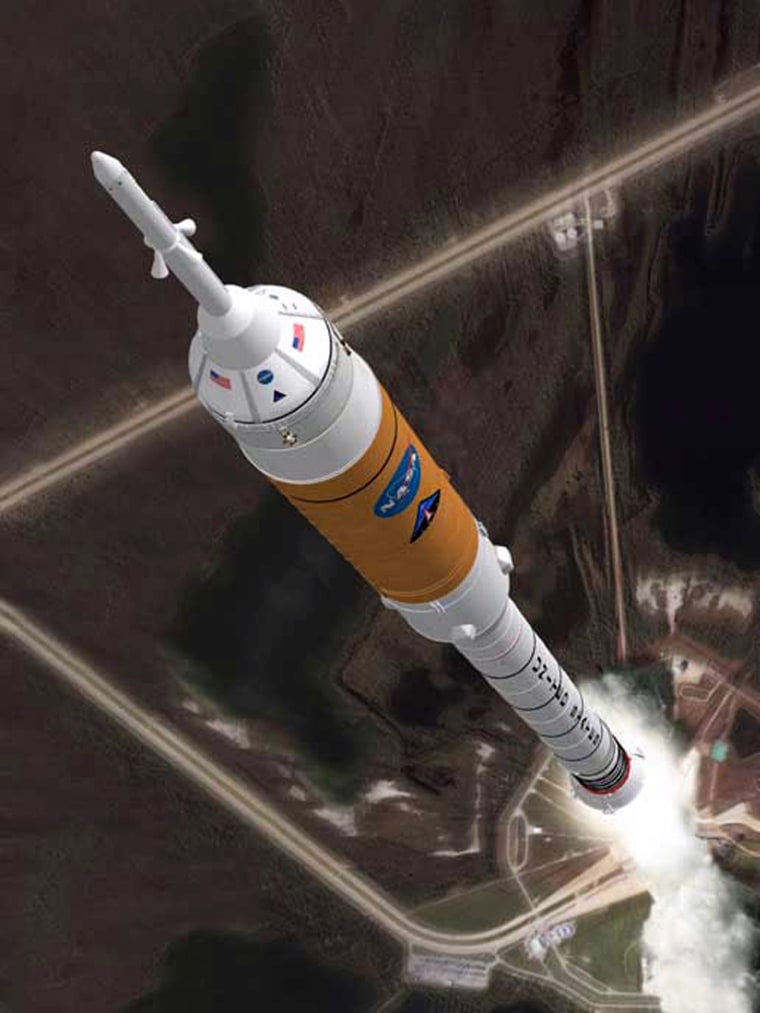NASA has sent scale-sized versions of its planned Orion spaceship plummeting back to Earth in a series tests to pinpoint the best way to return future astronauts safely back to terra firma.
The drop tests, performed at NASA’s Virginia-based Langley Research Center, are just one of several technical milestones the Orion spacecraft and Ares rocket programs hit in recent weeks as the agency pushes ahead with plans for its space shuttle successor.
“It’s a technology development effort right now to look at what is the best system for us to use for landing,” Orion project manager Caris ‘Skip’ Hatfield told SPACE.com, adding that the capsule-based vehicle will cushion its landing with either sausage- or wedge-shaped airbags. “We’re going through now and looking at various configurations of airbags.”
The Orion project completed a critical system requirements review this month with Lockheed Martin, NASA’s prime contractor of the project, which laid the foundation for the spacecraft’s design and development. NASA also put out a call for proposals this month for contractors interested in supplying the upper stage of Orion’s Ares 1 rocket booster, with engine tests for its heavy-lift counterpart — the Ares V — are also underway.
“I think we’ve made a tremendous amount of progress,” Hatfield said.
NASA chief Michael Griffin has said the first crewed flight of an Orion spacecraft and its Ares booster will be delayed until at least March 2015 — well after the planned September 2010 retirement of the agency’s aging three-orbiter shuttle fleet — due to budget issues. That first operational launch was slated for September 2014.
“It doesn’t change the design so much to have that slip, it’s really a project management issue,” Hatfield said of the slip, which Griffin has attributed to a $575 million shortfall in the agency’s expected 2007 exploration budget.
Chubby spacecraft
Hatfield said one of Orion’s major steps forward was a successful weight loss program to shave excess mass off the hefty vehicle.
“We are now back into the weight requirements where we want to be,” Hatfield said.

A series of design changes following NASA’s selection of Lockheed Martin to build Orion capsules found the 50,265-pound (22,800-kilogram) spacecraft to be about 2,976 pounds (1,350 kilograms) overweight, though they were still light enough reach orbit atop an Ares 1 rocket, NASA has said.
While Hatfield pressed his project teams to streamline their systems to eliminate unnecessary weight wherever possible, the biggest savings came by encapsulating Orion’s service module, which houses the vehicle’s vital systems, with a shroud-like shell rather than align it with the exterior of its Ares 1 booster.
“Basically, it’s a lot more like a payload shroud on an expendable launch vehicle,” Hatfield said, adding that the service module’s exterior shell is now designed to peel off during launch at about the same time as Orion’s emergency rocket-laden escape tower. “We end up with more efficient payload mass to orbit because we can get rid of that extra mass on the way to orbit.”
Construction will soon begin on a boilerplate Orion capsule, a bare bones prototype designed for launch abort system tests, at NASA’s Langley center as Lockheed engineers assemble to the first rocket motors for the spacecraft’s escape tower, Hatfield said. The Orion boilerplate and escape tower are expected to undergo their first field trials next fall at New Mexico’s White Sands Missile Range, he added.
This week, NASA also announced a five-year, $63 million plan to perform a series of thermal, electromagnetic and sound and mechanical vibration tests for the Orion spacecraft at Plum Brook Station in the agency’s Ohio-based Glenn Research Center.
Booster steps
Slideshow 12 photos
Month in Space: January 2014
While work continues on the Orion capsule, a separate team of engineers is tackling the spacecraft’s two-stage Ares I and its heavy-lift counterpart the Ares V, both of which are slated to launch initially from NASA’s Pad 39B site at the Kennedy Space Center in Florida.
The Ares I rocket is designed to use a five-segment version of the four-segment shuttle solid rocket booster (SRB) and a liquid propellant-fueled upper stage to ferry new crews to the International Space Station (ISS) or onwards to the Moon. Proposals for the booster’s upper stage are due by April 13, and NASA officials expect to make their choice in August.
The Ares V is expected to haul heavy cargo, such as future lunar landers and rocket stages to send Orion crews towards the Moon, using two evolved rocket boosters and a core stage that draws on NASA’s shuttle and Saturn V expertise.
Several wind tunnel and computer modeling studies are underway to determine how Ares I and V boosters will behave during launch and control their roll rates, NASA officials have said. Ares V engineers have also staged a series of test firings for the booster’s RS-68 rocket engines, five of which will form the core of the heavy-lift rocket’s power plant [image].
“When you look back on it, it is absolutely amazing the progress we’ve made in a pretty short amount of time,” Hatfield said. “Hardware’s going to start appearing over the next couple to a few months.”
